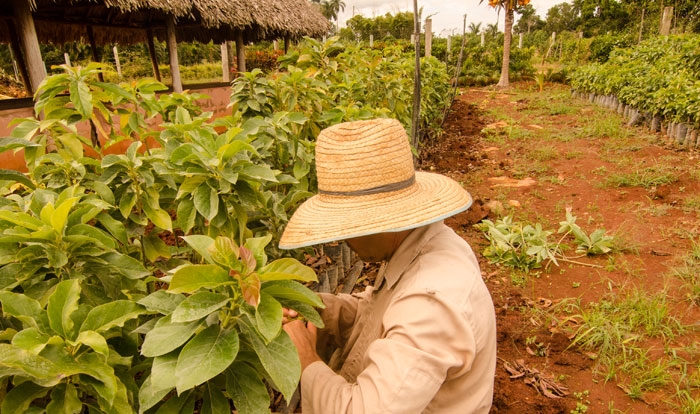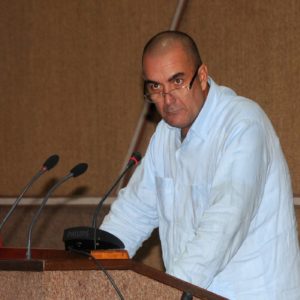
Agriculture in Las Tunas
LAS TUNAS – The year 2020 has begun and Cuba’s eastern province of Las Tunas again tries to derive, from its agricultural areas, at least 30 pounds of food — from vegetables, grains and roots — for each of its more than 530,000 inhabitants. This follows a government strategy started in 2016 whereby a figure is set, called the Municipal Self-Supply Program. It has yet to be achieved.
Out on the fields
The hallmark of the program here is not the drive for more bananas, cassava, sweet potatoes, corn, beans or rice — all in high demand for the domestic table, and for other things such as livestock feeding. The difference is that now, in order to obtain them from producers, the resources are placed in spaces previously defined by their natural conditions and previous infrastructure — remains of productive plans that fell out of favor after the economic crisis of the 1990s. At that time most of the agricultural production was borne by state farms. Three decades later, the task is in other hands: about 20,301 private producers, 85.6 percent associated with cooperatives of agricultural production or credits and services.
In the last three years in Las Tunas, 31 productive areas or zones were created; the most successful, Melanio Ortiz, covers more than 5,000 hectares [one hectar = 107,639 square feet or 2.47 acres] of land from 16 different cooperatives. “We want the producer to be in the field, to have the conditions to work, for the technician to have his home. Creating these conditions is the only way to have sustainability and variability in the numerous crops, ”said Omar Yoel Pérez López, the territory’s delegate of the Ministry of Agriculture.

Towards the end of 2018, Ydael Pérez Brito, first vice minister of Agriculture, said that none of Cuba’s provincial capitals, including Las Tunas, had achieved the goal of self-sufficiency. He said it was why agricultural productive zones had been established in the municipalities to help provide them with these foods.
At the beginning of last year, official numbers published demonstrated that these zones had only complied with the amounts agreed to for education, health and other subsidized institutions belonging to State-subsidized services. During the rest of the year the situation did not vary too much; always with the difficulty noted since the beginning of the last decade by experts from the local University: The natural conditions of Las Tunas for agriculture are comparatively worse than those in other regions of the country due to the poor quality of its soils and cultivating areas.
Public expenditures faced these disadvantages while investments were made in 2019 that included the installation of 500 irrigation systems to double the 4,500 hectares of land that are now artificially supplied with water. If these efforts bear fruit, the land benefitted would only increase four percentage points with respect to the total arable area.
Minister Gustavo Rodríguez Rollero summarized the 2019 economy by confirming that the lack of fertilizer was also to blame for the fall of the area’s yield — almost 50 percent. Irreparable damage was also the result of the lack of fuel suffered, starting in September, when the U.S. economic blockade was tightened during the cold planting season scheduled to culminate this February and on which the main crops of the middle of this year depend. In fact, only two-thirds of the planned areas were able to be planted.
In the markets
From 2016 to the present, the Cuban government also retraced steps in order to rescue the Collection Companies Union (Acopio) so that most of the agricultural production be placed in state markets guaranteeing consumers enough products to make one purchase a week. Acopio’s participation in the supply of agricultural products is particularly important for provinces such as Las Tunas, whose fields still do not meet the needs of its inhabitants.
Enel Espinosa, the ministry’s director of Agriculture, said that institutional efforts have not yet managed to resolve several of Acopio’s problems, which include: the low level of contracting with growers of the existing food produced; the transfer of these products to provinces that cannot meet their needs; the high costs of transportation; and a coherent strategy of planting that ensures an assortment of products needed according to the time of the year.
In the past two years, the Las Tunas Acopio improved conditions of about 20 storage facilities, as well as of its automotive fleet. In 2018 alone, it invested more than 600,000 pesos to renew its markets and locations to sell the products, as well as its warehouses. Javier Ramón Velázquez Morales, an Acopio representative, last July stated that in order for Las Tunas — especially when supplying the province’s capital — to meet agricultural requirements for its people they must look to other geographical areas in Cuba.
Recently the province’s authorities reorganized Las Tunas’ main market basically pursuing greater control over the arrival, storage and sale of the different agricultural products.
Citizens constantly objected to the trend of concentrating all products for sale in one place. The local media suggested diversifying sales locations for vegetables and fish, for example. Luis Manuel Peralta, of the Agriculture Ministry in Las Tunas, said that the most populous places in the city would keep selling products beyond the usual Sundays.
Peralta added that “around 27,600 kilograms of food, vegetables, fruits and grains are put up for sale every weekend in that emblematic space [the main market]. It is a considerable figure, based on the situation the country’s in, although maintaining stability is transcendental.”
There are plans in 2020 to grow bananas in more than 1,000 hectares of land, and add another 2,300 hectares with artificial irrigation. It is a clear sign of the commitment to intensive agriculture in Las Tunas. One main reason for this is that only about 22.8 pounds of agricultural products per capita are produced, an insufficient amount when dealing with the number of inhabitants of the territorial capital.
Reaching the 30 pound quota per person in Las Tunas would mean that government here would have to purchase more than 166,000 tons of crops from growers. As of now they’ve only purchased half of what is needed to meet this goal. It is a clear reflection of the organizational problems in the agricultural system of Las Tunas, analyzed most recently during the visit of Cuban President Miguel Díaz-Canel.

